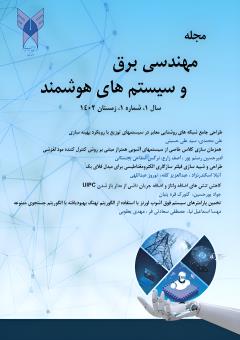طراحی و شبیه سازي فیلتر سازگاري الکترومغناطیسی براي مبدل فلاي بک
محورهای موضوعی : مهندسی برق ( الکترونیک، مخابرات، قدرت، کنترل)
آتیلا اسکندرنژاد
1
![]() ,
عبدالعزیز کلته
2
,
نوروز عبداللهی
3
,
عبدالعزیز کلته
2
,
نوروز عبداللهی
3
1 - دانشگاه آزاد اسلامی واحد علی آباد کتول، علی آباد کتول، ایران
2 - استادیار گروه برق دانشگاه آزاد واحد علی آباد کتول
3 - گروه مهندسی برق، واحد علی¬آباد کتول، دانشگاه آزاد اسلامی، علی¬آباد کتول، ایران
کلید واژه: سازگاری الکترومغناطیسی, فیلتر هدایتی, مبدل فلای¬بک, مدل نویزی,
چکیده مقاله :
تجهيزات الکترونیکی نيازمند ولتاژ تغذيه با مقادير مختلفي میباشند که در شرایط تغییر ولتاژ منبع و جریان بار بتواند ولتاژی تثبیت شده در خروجی ایجاد نماید. مبدل فلاي¬بك گزینه مناسبی است زیرا می¬تواند چندین سطح ولتاژی در ثانویه ایجاد کند. نکته دیگر آن است که امروزه به دلیل بالا بودن فرکانس سوئیچینگ، مولفه هاي الكترومغناطيسي با توان قابل توجهي از سمت مبدل به خطوط تغذیه هدایت شده و همچنین به فضاي اطراف تشعشع یابد که باعث تولید آلودگی الکترومغناطیسی و تداخل راديويي EMI شود. در این مقاله روشی موثر و عملی برای طراحی و تنظیم فيلتر سازگاري الكترومغناطيسي EMC ارائه میشود. تنظيم مقادير فيلتر مبتني بر متوسط¬گیری مدار نویز با در نظر گرفتن امپدانس معادل آن میباشد. در اغلب روش¬های پیشنهادی برای طراحی فیلتر، منبع نویز را به صورت یک منبع جریان ایده¬آل فرض کرده و امپدانس معادل نویز را در نظر نمیگیرند. این موضوع از دقت طراحی کاسته و مانع از فیلتر شدن درست مولفه¬ها در برخی فرکانسها میشود. در این مقاله متوسط¬گیری مداری از کل ساختار مبدل با در نظر گرفتن عناصر پارازیتی انجام می¬شود زیرا هر چه مدل ارائه شده به ساختار واقعی نزدیکتر باشد فيلتر كارآئي بيشتري داشته و به طور موثرتري مولفه هاي مزاحم راديويي را از بين میبرد. در انتها، شبيه¬سازي نرم¬افزاری نشان¬دهنده دقت و کارآیی روش پیشنهادی در طراحی فیلتر EMI است.
Electronic equipment's require supply voltage with different values that can create a stabilized voltage at the output in the conditions of changing the source voltage and load current. The flyback switching converter is a suitable option for producing different voltages in such conditions. Due to the high frequency switching, the electromagnetic components with significant power are directed from the converter side to the power lines and also radiated to the surrounding space, which causes electromagnetic pollution and EMI radio interference. In this article, an effective and practical method for designing and adjusting the EMC electromagnetic compatibility filter is presented. Adjusting the filter values is based on averaging the noise circuit by considering its equivalent impedance. In most of the proposed methods for filter design, the noise source is assumed as an ideal current source and the equivalent impedance of the noise is not considered. This reduces the accuracy of the design and prevents the correct filtering of the components in some frequencies. In this article, the circuit averaging of the entire structure of the converter is done by considering the parasitic elements, because the closer the presented model is to the real structure, the more effective the filter is, and the more effectively it removes radio interference components. In the end, the software simulation shows the accuracy and efficiency of the proposed method in EMI filter design.
[1] D. E. Quevedo and G. C. Goodwin, "Control of EMI from Switch-Mode Power Supplies via Multi-Step Optimization", Proceedings of the 2004 American Control Conference, USA, January 2004, pp. 1123-1128.
[2] A. Manjunath and M.L. Sudheer, "Conducted Emi Model for Flyback PFC Converter", International Journal of Recent Technology and Engineering, Vol. 8, No. 3, 2019, pp. 6916-6923.
[3] J. Yao, Y. Li, Z. Ma and Sh. Wang, "Advances of Modeling and Reduction of Conducted and Radiated EMI in Flyback Converters", IEEE Energy Conversion Congress and Exposition (ECCE), USA, 2020, pp. 834-839.
[4] Y. Li, H. Zhang, S. Wang, H. Sheng, C. P. Chng and S. Lakshmikanthan, "Investigating Switching Transformers for Common Mode EMI Reduction to Remove Common Mode EMI Filters and Y-Capacitors in Flyback Converters," IEEE Journal of Emerging and Power Electronics, Vol. 6, 2018, pp. 2287-2301.
[5] Y. Li, S. Wang and H. Sheng, "Investigate and Reduce Capacitive Couplings in a Flyback Adapter With a DC-Bus Filter to Reduce EMI", IEEE Transactions on Power Electronics, Vol. 35, 2020, pp. 6963-6973.
[6] J. Yao, Y. Li, S. Wang, X. Huang and X. Lyu, "Analysis and Reduction of Radiated EMI in High-Frequency GaN IC-based Active Clamp Flybac, Converters", IEEE Applied Power Electronics Conference and Exposition (APEC), 2020, pp. 664-671.
[7] M. R. Yazdani, H. Farzanehfard, and J. Faiz, "EMI Analysis and Evaluation of an Improved ZCT Flyback Converter", IEEE Transactions on Power Electronics, Vol. 26, 2011, pp. 2326-2334.
[8] S. Tammana and S. Yellampalli, "EMI Design for DC-DC Converters", International Journal of Recent Technology and Engineering (IJRTE), Vol. 7 , March 2019, pp. 74-79.
[9] H. Li et al., "Conducted EMI simulation of switched mode power supply", IEEE International Symptom on Electromagnetic Compatibility, USA, 2009, pp. 155-160.
[10] L. Xie, X. Ruan, H. Zhu and Y. Lo, "Common-Mode Voltage Cancellation for Reducing the Common-Mode Noise in DC-DC Converters", IEEE Transactions on Industrial Electronics, Vol. 68, No. 5, 2021, pp. 3887-3897.
[11] Ashritha M. and M L Sudheer, "Conducted Emi Model for Flyback PFC Converter", International Journal of Recent Technology and Engineering (IJRTE), Vol. 8, No.3, 2019, pp. 6916-6923.
[12] I. Lou, Q. Sun, W. You and Y. Sh, "Analytical Calculation of Conducted EMI in Flyback Converters", Asia-Pacific International Symposium on Electromagnetic Compatibility & Signal Integrity (APEMC), 2016, pp. 241-248.


